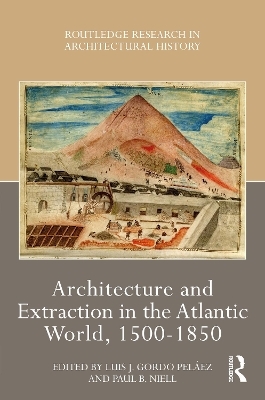
Architecture and Extraction in the Atlantic World, 1500-1850
Routledge (Verlag)
978-1-032-43111-6 (ISBN)
This edited collection examines the development of Atlantic World architecture after 1492. In particular, the chapters explore the landscapes of extraction as material networks that brought people, space, and labor together in harvesting raw materials, cultivating agriculture for export-level profits, and circulating raw materials and commodities in Europe, Africa, and the Americas from 1500 to 1850.
This book argues that histories of extraction remain incomplete without careful attention to the social, physical, and mental nexus that is architecture, just as architecture’s development in the last 500 years cannot be adequately comprehended without attention to empire, extraction, colonialism, and the rise of what Immanuel Wallerstein has called the world system. This world system was possible because of built environments that enabled resource extraction, transport of raw materials, circulation of commodities, and enactment of power relations in the struggle between capital and labor. Separated into three sections: Harvesting the Environment, Cultivating Profit, and Circulating Commodities: Networks and Infrastructures, this volume covers a wide range of geographies, from England to South America, from Africa to South Carolina. The book aims to decenter Eurocentric approaches to architectural history to expose the global circulation of ideas, things, commodities, and people that constituted the architecture of extraction in the Atlantic World. In focusing on extraction, we aim to recover histories of labor exploitation and racialized oppression of interest to the global community.
The book will be of interest to researchers and students of architectural history, geography, urban and labor history, literary studies, historic preservation, and colonial studies.
Luis Gordo Peláez is Assistant Professor in the Department of Art, Design and Art History at California State University, Fresno. His work examines the urban reform projects and public works agenda of the late colonial Mexican cities, particularly in Bourbon Guanajuato and the region of El Bajío. Paul Niell is Associate Professor in the Department of Art History at Florida State University. His research focuses on the art, architecture, and material culture of the Hispanophone Caribbean in the late eighteenth and early nineteenth centuries.
List of figures
List of contributors
Introduction: Building for Atlantic Extraction.
Luis Gordo-Peláez and Paul Niell
Chapter 1. Early Modern Mining Exchanges across Empires
Janna Israel
Chapter 2. Purchasing a Poisoned City: Indigenous Andeans and Urban Space in Sixteenth-Century Huancavelica
Mark P. Dries
Chapter 3. New Functions of Mining Heritage in Mexico
Miguel Ángel Sorroche Cuerva
Chapter 4. The Ice House: Industry and Ritual in the Nineteenth-Century Frozen Water Trade
Louisa Iarocci
Chapter 5. Contesting the Colonial Illu: Sealing and Social Change in Kalaallit Architecture, 1750-1860
Kirstine Møller and Bart Pushaw
Chapter 6. From Ireland to Barbados: Architecture of Extraction in British Colonies
Lee Morrissey
Chapter 7. Whiteness Among People of Color at Atlantic World Extraction Sites: A Comparative Study of the Indigenous Diamond Hill and Black Melrose Plantations
Barry L. Stiefel
Chapter 8. Absentee Architecture: Remote Building Across the British Atlantic, c. 1800
Jonah Rowen
Chapter 9. Space, Science, and Slavery in Havana’s Botanical Garden
Lee Sessions
Chapter 10. The World’s Greatest Depot: West India Docks, Warehouses, and Flexibility
Georgios Eftaxiopoulos
Chapter 11. Choice Spirits or the Alloy of Slavery: Samuel Blodget’s First Bank of the United States
Peter Minosh
Chapter 12. Castle Brew: Dreams Realized and Dreams Devastated
Courtnay Micots
Chapter 13. Architecture of Indigo Dye Extraction in the Eighteenth-Century Atlantic Context: The Case of Charleston and Rio de Janeiro
Alexander Lima Reis
Chapter 14. From Caravans to Railroads: Trails, Architecture, and Urban Networks in Rio Pardo’s Eighteenth- and Nineteenth-Century Landscapes of Extraction
Rafael Augusto Silva Ferreira and Renata Baesso Pereira
Bibliography
Index
| Erscheinungsdatum | 14.12.2023 |
|---|---|
| Reihe/Serie | Routledge Research in Architectural History |
| Zusatzinfo | 9 Line drawings, black and white; 56 Halftones, black and white; 65 Illustrations, black and white |
| Verlagsort | London |
| Sprache | englisch |
| Maße | 156 x 234 mm |
| Gewicht | 700 g |
| Themenwelt | Naturwissenschaften ► Biologie ► Ökologie / Naturschutz |
| Technik ► Architektur | |
| Weitere Fachgebiete ► Land- / Forstwirtschaft / Fischerei | |
| ISBN-10 | 1-032-43111-3 / 1032431113 |
| ISBN-13 | 978-1-032-43111-6 / 9781032431116 |
| Zustand | Neuware |
| Informationen gemäß Produktsicherheitsverordnung (GPSR) | |
| Haben Sie eine Frage zum Produkt? |
aus dem Bereich


